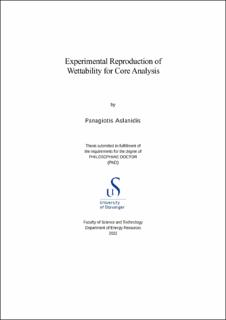| dc.contributor.advisor | Puntervold, Tina | |
| dc.contributor.advisor | Strand, Skule | |
| dc.contributor.author | Aslanidis, Panagiotis | |
| dc.date.accessioned | 2022-09-27T14:55:26Z | |
| dc.date.available | 2022-09-27T14:55:26Z | |
| dc.date.issued | 2022-09 | |
| dc.identifier.citation | Experimental Reproduction of Wettability for Core Analysis by Panagiotis Aslandis, Stavanger : University of Stavanger, 2022 (PhD thesis UiS, no. 658) | en_US |
| dc.identifier.isbn | 978-82-8439-110-6 | |
| dc.identifier.issn | 1890-1387 | |
| dc.identifier.uri | https://hdl.handle.net/11250/3021851 | |
| dc.description.abstract | The ideal scenario when core samples are retrieved from the field to the lab is to start the experiment immediately without any treatment. Due to a decrease in pressure and temperature from reservoir to standard conditions, fluid expansion occurs. The depressurized cores will not have a correct fluid saturation and need to be restored prior to laboratory core experiments. To achieve representative reservoir data from these tests, the restored core wettability needs to be close to reservoir conditions.
Wettability dictates the fluid flow in porous media, and the restored wettability will dramatically influence the results on capillary pressure, relative permeability, and oil recovery tests in laboratory experiments. Therefore, wettability should be preserved in-between restoration processes.
The wettability of a core retrieved in the lab can be affected during cleaning and restoration procedures. A wide range of cleaning techniques are followed in laboratories including different solvents, experimental set-ups, methods, etc. The same applies in core restoration, where the restoring protocol differs from one lab to another including establishing initial water saturation, crude oil exposure, the aging process, etc.
In this project, several reservoir sandstone and outcrop carbonate cores, underwent a series of experiments in regard to wettability. The solvents utilized during core cleaning and the amount of crude oil exposed to the core during core restoration were the study's major emphasis. In this work, two cleaning procedures were compared: a mild approach (kerosene and heptane) and a more rigorous industrial standard used (toluene/methanol). Amount of, 1, 5, and 11 pore volumes (PV) of crude oil was utilized to evaluate the effect of crude oil exposure in the wettability of a system. Finally, an adsorption test on a sandstone reservoir core was performed to provide more thorough monitoring of the influence of crude oil in the sandstone rock surface.
The findings indicated that mild cleaning followed by an uncontrolled quantity of crude oil exposure might have a substantial influence on the wettability of the system, causing it to become less water-wet. A more comprehensive adsorption test on the reservoir sandstone core demonstrated that polar organic components (POC) continue to adsorb on the mineral surface even after many PV injections. However, the use of more rigorous solvents resulted in the reverse situation, resulting in more water-wet conditions. Finally, the use of mild solvents with just 1 PV of crude had no effect on the wettability of the systems between restorations.
In conclusion, this doctoral thesis proposes an efficient core cleaning and restoration process in which the wettability of the cores is replicated from one restoration to the next. | en_US |
| dc.language.iso | eng | en_US |
| dc.publisher | University of Stavanger, Norway | en_US |
| dc.relation.ispartofseries | PhD thesis UiS; | |
| dc.relation.ispartofseries | ;658 | |
| dc.relation.haspart | Paper 1: “Reproducing wettability in sandstone reservoir core material in laboratory core restorations”, P. Aslanidis, S. Strand, T. Puntervold, I. D. Piñerez T. Journal of Petroleum Science and Engineering, 109531, 2021 doi:https://doi.org/10.1016/j.petrol.2021.109531 | en_US |
| dc.relation.haspart | Paper 2: “Core wettability reproduction: A new solvent cleaning and core restoration strategy for chalk cores”, I. D. Piñerez T., T. Puntervold, S. Strand, P. Hopkins, P. Aslanidis, H. S. Yang, M.S. Kinn. Journal of Petroleum Science and Engineering, 195, 107654, 2020 doi:https://doi.org/10.1016/j.petrol.2020.107654 | en_US |
| dc.relation.haspart | Paper 3: “Core restoration and its effect on initial wetting of NCS sandstone reservoir cores”, P. Aslanidis, I. D. Piñerez T., S. Strand, T. Puntervold. Peer reviewed paper presented at the 35th International Symposium of the Society of Core Analysts, Texas, US, 2021. This paper is not available in Brage for copyright reasons. | en_US |
| dc.relation.haspart | Paper 4: “Influence of sandstone mineralogy on the adsorption of polar crude oil components and its effect on wettability”, A. Mamonov, P. Aslanidis, T. Puntervold, S. Strand, N. Fazilani, Energy and Fuels, 2022 doi:https://doi.org/10.1021/acs.energyfuels.2c01540 | en_US |
| dc.rights | Navngivelse 4.0 Internasjonal | * |
| dc.rights.uri | http://creativecommons.org/licenses/by/4.0/deed.no | * |
| dc.subject | wettability | en_US |
| dc.subject | reservoir technology | en_US |
| dc.subject | brønnteknologi | en_US |
| dc.title | Experimental Reproduction of Wettability for Core Analysis | en_US |
| dc.type | Doctoral thesis | en_US |
| dc.rights.holder | © 2022 Panagiotis Aslanidis | en_US |
| dc.subject.nsi | VDP::Teknologi: 500::Berg‑ og petroleumsfag: 510 | en_US |

